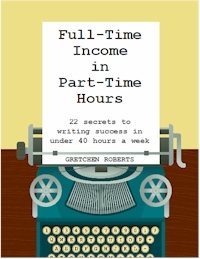 A part-time freelance writer for the past eight years, Gretchen Roberts quit the corporate world to balance work and kids and never looked back. She writes about food, wine, home and gardens for national consumer magazines and websites such as Better Homes & Gardens, Real Simple, Woman’s Day, and HGTV.com. She also does marketing development and copywriting for companies including Rich Products, Kroger, Lowe’s and Costco. Roberts put what she’s learned about maximizing a limited work week into a new book, Full-Time Income in Part-Time Hours: 22 Secrets to Writing Success in Under 40 Hours a Week.
A part-time freelance writer for the past eight years, Gretchen Roberts quit the corporate world to balance work and kids and never looked back. She writes about food, wine, home and gardens for national consumer magazines and websites such as Better Homes & Gardens, Real Simple, Woman’s Day, and HGTV.com. She also does marketing development and copywriting for companies including Rich Products, Kroger, Lowe’s and Costco. Roberts put what she’s learned about maximizing a limited work week into a new book, Full-Time Income in Part-Time Hours: 22 Secrets to Writing Success in Under 40 Hours a Week.
In this guest post, Roberts shares what she’s learned:
Earn a full-time living while only putting in part-time hours? Sounds like some kind of internet work-from-home scam.
It’s not.
I’ve been writing professionally since 2003, and depending on my kids’ and sitters’ schedules, have always worked between 15 and 20 hours a week. Except for the first few years when I was ramping up the business, I’ve earned between $40,000 and $70,000 a year.
Here are five tips for maximizing your working hours:
1. Never start the workday without a plan. When your hours are limited, you can’t afford to waste a minute figuring out a to-do list for the day. Before you even sit down to work, have a task list ready to go. I always make my list the last few minutes of the previous workday, when I’m in the zone and know the status of each project. The next time I start work, which depending on my schedule could be several days later, my list is ready and so am I. I dive right in and get a ton more accomplished.
 2. Set revenue goals. Many freelancers hesitate to set revenue goals because income is so unpredictable. But the up-and-down nature of freelancing makes setting goals even more important. You’ve got to have a clear idea of how much money you want to make so you have something to aim for. Set a yearly goal, and then break it down by quarter and month. If your monthly goal is $5,000 but one month you make $4,000, you know you’ve got to ramp up marketing to make up the slack. If you don’t set and actively monitor revenue goals, your could get a surprise at the end of the year – and rare is the freelancer surprised at how much more she brought in than she realized. Revenue goals are even more important for part-timers. It’s too easy to think of freelancing income as grocery money or gravy. Take your work, and the amount you want to earn from it, seriously.
2. Set revenue goals. Many freelancers hesitate to set revenue goals because income is so unpredictable. But the up-and-down nature of freelancing makes setting goals even more important. You’ve got to have a clear idea of how much money you want to make so you have something to aim for. Set a yearly goal, and then break it down by quarter and month. If your monthly goal is $5,000 but one month you make $4,000, you know you’ve got to ramp up marketing to make up the slack. If you don’t set and actively monitor revenue goals, your could get a surprise at the end of the year – and rare is the freelancer surprised at how much more she brought in than she realized. Revenue goals are even more important for part-timers. It’s too easy to think of freelancing income as grocery money or gravy. Take your work, and the amount you want to earn from it, seriously.
3. Develop anchor clients. Anchor clients, editors and corporate clients who use you again and again, are the foundation of a part-time freelancer’s house. Work you can count on helps make meeting revenue goals that much easier, which means you can spend less of your precious time marketing and more writing, and earning.
4. Be the best professional you can be. How do you get anchor clients? Editors and corporate clients will come back repeatedly if you turn in good work, make yourself available for and amenable to revisions as necessary and generally make their lives easier. Anticipate how to do that, or ask. I try to remember that my clients have their own pressures from bosses, clients and advertisers, and may have different goals for my copy than I do.
5. Set your sights high. If you don’t believe you deserve the big projects, the highest per-word rate, the feature stories, who will? Be humble, build up your body of work, and then go for the good stuff.
Full-Time Income in Part-Time Hours: 22 Secrets to Writing Success in Under 40 Hours a Week is available in PDF, Amazon Kindle and iBook versions (Barnes & Noble NOOK and Sony eReader versions coming soon) for $7.99. Find out more at www.writeparttime.com.
I’d make one addition which is a tough one for me: Don’t start the day reading all your email!
Good one.
MVR
Michelle,
Thanks for offering this guest post!
Gretchen,
Thanks for offering such simple, practical tips. They are all part of how I work already, but I’m now going to focus on each one individually to see what rewards it can bring.
Agreed. Five great, succinct secrets for maximizing freelance work. I think freelancers often aim too low when their skills and experience can carry them higher than they think.
I think #5 is the most important, but I would tweak it a bit. “Charge what you’re worth and what the market commands”. SOOO many freelance writers undervalue their work and charge less than $50/hour, or worse still – get sucked into content mill operations that pay $5 or $10 per article. My hourly rate is $125, and I have never had a client flinch. I left my job about 6 months ago to freelance full time. My hours are still somewhat part time, but I’m currently on track to crack $70,000 or more. Everything you wrote is entirely realistic and do-able.
Great advice. I totally agree that too many writers under-price themselves – and I’ve been one of them. When you bid a job add 10 percent to 30 percent to the total to cover the unexpected – because inevitably something will happen that you didn’t account for.
MVR
Great tips, thank you! The biggest time waster for me is social media. Those tweets come through thick and fast and before I know it, three hours have passed!
I hear you!
MVR